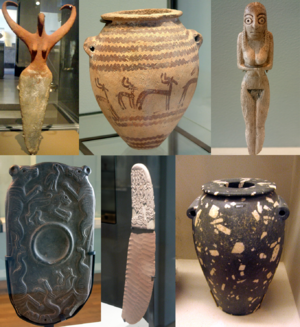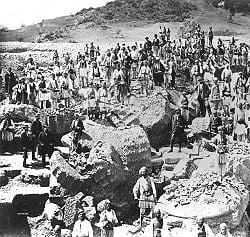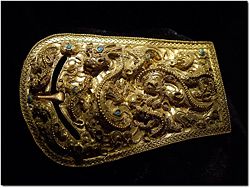Difference between revisions of "Artifact (archaeology)" - New World Encyclopedia
(Subheading) |
|||
| Line 22: | Line 22: | ||
== Use of artifacts in archaeological analysis == | == Use of artifacts in archaeological analysis == | ||
[[Image:OlympiaGermanExcavation.jpg|thumb|250px|The 1875-1881 German excavation of [[Olympia]], [[Greece]].]] | [[Image:OlympiaGermanExcavation.jpg|thumb|250px|The 1875-1881 German excavation of [[Olympia]], [[Greece]].]] | ||
| − | + | identification, classification, quantification, data manipulation, and analysis | |
| + | Artifacts are often called "finds" when handled during archaeological [[excavation]]. Artifacts are related to the archaeological record by their position defined by the [[Archaeological context]] they are discovered in. This is important for [[Seriation]] and relative dating analysis and is closely related to work post excavation with the use of a [[Harris matrix]] created during excavation. An analysis of finds is often made during excavation for the purpose of spot dating, which is a process of assessing dates of contexts being excavated. It is used as a form of confirmation concerning [[Archaeological phase|phasing]] and highlighting any potential for further discovery on a given site as it progresses. Spot dating tends to rely on pottery typology. This pottery dating analysis was pioneered by 19th century archaeologists such as [[Georg Loeschcke]]. Apart from dating and supporting the process of excavation, artifacts lend themselves to a host of post excavation disciplines. | ||
==Notes== | ==Notes== | ||
Revision as of 14:09, 17 June 2008

Artifact - A Definition
In archaeology, an artifact or artefact is any object made or modified by a human culture, and often one later recovered by some archaeological endeavor. Examples include stone tools such as projectile points, pottery vessels, metal objects such as buttons or guns, and items of personal adornment such as jewellery and clothing. Other examples include bone that show signs of human modification, fire cracked rocks from a hearth or plant material used for food.
The study of these objects is an important part of the field of archaeology, although the degree to which they represent the social groupings that created them is a subject over which archaeological theoreticians argue. Focusing on the artifact alone can produce very intensive and enlightening work on the object itself but can ignore surrounding factors which may shed further light on the manufacturing society. Traditional museums are often criticised for being too artifact-led, that is by displaying items without any contextual information about their purpose or the people who made them.
Artifacts can come from any archaeological context or source such as:
- Buried along with a body (grave goods).
- From any feature such as a midden or other domestic setting
- Hoards
- Votive offerings
Artifacts are distinguished from the main body of the archaeological record such as stratigraphic features, which are nonportable remains of human activity, such as hearths, roads, or deposits and remains, and from biofacts or ecofacts, which are objects of archaeological interest made by other organisms, such as seeds or animal bone.
Natural objects which have been moved but not changed by humans are called manuports. Examples would include seashells moved inland or rounded pebbles placed away from the water action that would have fashioned them.
These distinctions are often blurred; for instance, a bone removed from an animal carcass is a biofact, but a bone carved into a useful implement is an artifact. Similarly there can be debate over early stone objects which may be crude artifacts or which may be naturally occurring phenomena that only appear to have been used by humans.
Use of artifacts in archaeological analysis

identification, classification, quantification, data manipulation, and analysis
Artifacts are often called "finds" when handled during archaeological excavation. Artifacts are related to the archaeological record by their position defined by the Archaeological context they are discovered in. This is important for Seriation and relative dating analysis and is closely related to work post excavation with the use of a Harris matrix created during excavation. An analysis of finds is often made during excavation for the purpose of spot dating, which is a process of assessing dates of contexts being excavated. It is used as a form of confirmation concerning phasing and highlighting any potential for further discovery on a given site as it progresses. Spot dating tends to rely on pottery typology. This pottery dating analysis was pioneered by 19th century archaeologists such as Georg Loeschcke. Apart from dating and supporting the process of excavation, artifacts lend themselves to a host of post excavation disciplines.
Notes
ReferencesISBN links support NWE through referral fees
- Margolis, Eric, and Stephen Laurence. 2007. Creations of the mind: theories of artifacts and their representation. Oxford: Oxford University Press. ISBN 9780199250981
- Ewen, Charles Robin. 2003. Artifacts. Archaeologist's toolkit, v. 4. Walnut Creek, CA: AltaMira Press. ISBN 075910400X
- Mills, Elizabeth Shown. 2007. Evidence Explained: Citing History Sources from Artifacts to Cyberspace. Baltimore, Md: Genealogical Pub. Co. ISBN 9780806317816
- Kipfer, Barbara Ann. 2007. Dictionary of Artifacts. Malden, MA: Blackwell Publishing. ISBN 1405118873
- Schiffer, Michael B., and Andrea R. Miller. 2002. The Material Life of Human Beings Artifacts, behavior, and Communication. London: Routledge. ISBN 020325807X
- Rachlin, Harvey. 1996. Lucy's bones, sacred stones, & Einstein's brain: the remarkable stories behind the great objects and artifacts of history, from antiquity to the modern era. A Henry Holt reference book. New York: H. Holt. ISBN 0805039643
External Links
Credits
New World Encyclopedia writers and editors rewrote and completed the Wikipedia article in accordance with New World Encyclopedia standards. This article abides by terms of the Creative Commons CC-by-sa 3.0 License (CC-by-sa), which may be used and disseminated with proper attribution. Credit is due under the terms of this license that can reference both the New World Encyclopedia contributors and the selfless volunteer contributors of the Wikimedia Foundation. To cite this article click here for a list of acceptable citing formats.The history of earlier contributions by wikipedians is accessible to researchers here:
The history of this article since it was imported to New World Encyclopedia:
Note: Some restrictions may apply to use of individual images which are separately licensed.
